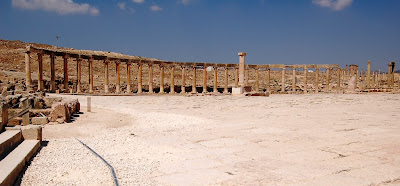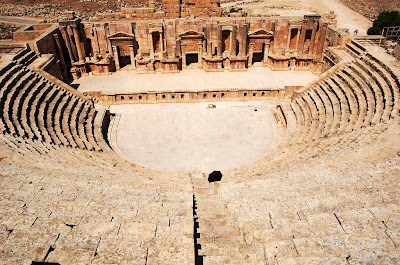 Some of it was on a very human scale, small memorials to lesser men, now wearing a little thin and showing signs of age.
Some of it was on a very human scale, small memorials to lesser men, now wearing a little thin and showing signs of age.
But then some were on a grand scale, like the Tomb of the Urn:
The Urn tomb, high on the cliffs, was also showing signs of the ravages of time, but the beautiful colours in the rocks made up for the loss of detail.
There is a thesis that the damage to the lower part of the monument is caused by rising water levels. I think this is nonsense, and that the Nabateans cut into the natural water level and thereby sealed the fate of the lower sections. There is a huge chamber inside the Urn tomb. It was quite clear why - and how - it had become a Byzantine church, in the 5th century AD.
From the platform in front of the Urn tomb, the mountains across the south of the site loom large. The Monastery, which we visited next, is behind the left-hand hill. In the shade, it was pleasantly cool. Out there, in the desert, it was HOT!

When we came out of the museum into the afternoon heat, our courage failed us. The two children were summoned, and, to the amusement of the professional muleteers, who advised us that the children were not to be trusted, off we set up the mountain. The path was narrow, and the drops on either side soon became impressive, but nothing was as impressive as the sure-footedness of our tiny mounts. Finally our guides said we should walk the last few hundred metres, so, shakily, we made our way along the path, through a narrow gap, and down onto an open plain. Ahead was another cafe, and we were halfway there when I caught a glimpse of something out of the corner of my eye, and there, behind us, was a truly spectacular piece of work.

After a cooling drink, it was time to brave the ride down. The Traveller was terrified! "Lean back!" I would call, as she threatened yet again to take a dive over the donkey's head. The youngster insisted on holding her arm - "Don't worry, madam." I was laughing so much I forgot to take a picture.
Finally we were down. More ruins to explore, and then the long slog back to the Siq. It seemed to be even hotter. At that moment, a man hove in view leading three camels. Protracted negotiations, then we were off!
The camel's expression says it all!
We were dropped at the Treasury, and made our way one last time up the Siq.




 Strictly speaking, it was the Crusader castle of Mons Realis or "Montreal." Much of the top was in a state of ruination, with the great spherical boulders catapulted there during a siege to show why it was in such a bad shape. Best preserved was the North-West watchtower, reconstructed by the Arabs in the 13th Cent after they had destroyed the original while capturing the castle.
Strictly speaking, it was the Crusader castle of Mons Realis or "Montreal." Much of the top was in a state of ruination, with the great spherical boulders catapulted there during a siege to show why it was in such a bad shape. Best preserved was the North-West watchtower, reconstructed by the Arabs in the 13th Cent after they had destroyed the original while capturing the castle. 






 The chamber inside the Treasury was devoid of objects or decoration - but the natural decoration on the roof and walls fully made up for the lack!
The chamber inside the Treasury was devoid of objects or decoration - but the natural decoration on the roof and walls fully made up for the lack!  It was getting late. The camels were being gathered before being taken home. We would head up the narrow crack opposite, the entrance to the Siq, and head back to our hotel to return the next day.
It was getting late. The camels were being gathered before being taken home. We would head up the narrow crack opposite, the entrance to the Siq, and head back to our hotel to return the next day.
 Then into the Hippodrome, where even today there are chariot races. This is a view from the race track back towards the starting gates:
Then into the Hippodrome, where even today there are chariot races. This is a view from the race track back towards the starting gates:

 The hill on the left leads up past a great temple to a theatre from which came the unlikely sound of bagpipes. It was a local, uncannily clad in a kilt, welcoming visitors to his stage!
The hill on the left leads up past a great temple to a theatre from which came the unlikely sound of bagpipes. It was a local, uncannily clad in a kilt, welcoming visitors to his stage! The black splodge in the centre is the Traveller, hiding her fevered brow under a black umbrella. It was extremely hot.
The black splodge in the centre is the Traveller, hiding her fevered brow under a black umbrella. It was extremely hot. Looking down from the top row of the theatre, below was the circular forum and the great main street stretching out for several kilometers, lined by pillars, with modern Jarash in the background.
Looking down from the top row of the theatre, below was the circular forum and the great main street stretching out for several kilometers, lined by pillars, with modern Jarash in the background. And, of course, there were marvellous temples where the faithful could go to worship Artemis, because Christianity had not yet reached the town.
And, of course, there were marvellous temples where the faithful could go to worship Artemis, because Christianity had not yet reached the town. It was therefore a surprise to find, in the museum on our way out of the site, a gravestone in the form of a cross. The date, which translated to 26BC, reminded us that Christian symbolism had a pre-Christian ancestory.
It was therefore a surprise to find, in the museum on our way out of the site, a gravestone in the form of a cross. The date, which translated to 26BC, reminded us that Christian symbolism had a pre-Christian ancestory.




 There were yet more Roman ruins in the centre of the town. This forum was the entrance to a huge theatre.
There were yet more Roman ruins in the centre of the town. This forum was the entrance to a huge theatre.



